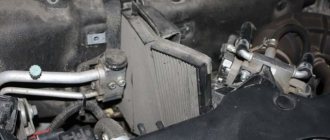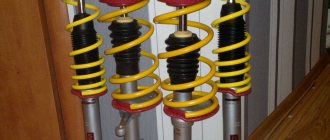LADA (VAZ) Priora
Lada Priora is one of the most popular cars in Russia. Compared to other AvtoVAZ models, the Priora has the most attractive appearance, which is why it is in good demand among Russians. And the government fueled interest in Priora and other VAZ products through various programs, one of which was the recycling of used cars, which began in the country on March 8, 2010.
Lada Priora is available in various versions equipped with gasoline engines - an 8-valve 87-horsepower and a 16-valve 106-horsepower engine. The volume of these engines is 1.6 liters. These engines are equipped with a 5-speed manual transmission. The maximum speed of the 87-horsepower unit is 176 km/h, and the 106-horsepower unit is 183 km/h. Average fuel consumption is 7.3 liters per 100 km.
The minimum cost of a new Lada Priora 2016 is 389,000 rubles. This is almost an “empty” package, but it has one airbag for the driver, electric power steering, ABS+BAS, audio preparation, electric front doors and an alarm system with central locking.
The most expensive version of the Lada Priora costs 464,000 rubles. Under the hood of this modification there are 106 “horses”, and among its equipment there are an anti-lock braking system (ABS + BAS), a driver airbag, a safe parking system, fog lights, audio preparation, an on-board computer, a climate system, heated seats, electric drive and heated exterior mirrors, four electric windows and R14 wheels.
Priora in a station wagon
Lada Priora Universal is a car that entered the market in May 2009. The Priora station wagon replaced the Lada 111 in the AvtoVAZ model range, which was produced from 1999 to 2009.
Lada Priora Wagon is equipped with a 16-valve 1.6-liter gasoline engine with a capacity of 98 horsepower. This engine is equipped with a five-speed manual transmission. The Priora Station Wagon accelerates from zero to hundreds in 12 seconds, and its top speed is 183 km/h. Average fuel consumption is 7.3 liters per 100 km.
The length of the car is 4330 mm, width - 1680 mm, height - 1508, wheelbase - 2492 mm. The luggage compartment volume is 444 liters, increasing to 777 liters with the rear seats folded. Curb weight – 1088 kg.
The minimum price of a Lada Priora Universal for 2011 was 336,300 rubles. This is the Norma package, which is equipped with one airbag, power steering, central locking with remote control, electric drive and heated mirrors, front electric windows, audio preparation and roof rails.
The most expensive version “Lux”, costing 397,300 rubles, is equipped with an anti-lock brake system (ABS), two airbags, parking sensors, climate control, fog lights, an on-board computer, four electric windows, light and rain sensors, alloy wheels.
Priora in a coupe body
Lada Priora Coupe entered the Russian market in 2010. The car is built on the platform of the five-door hatchback Lada Priora and has a stylish appearance and a more comfortable interior. Under the hood of the LADA Priora Coupe there is a 16-valve 1.6-liter gasoline engine with a capacity of 98 horsepower, which is equipped with a 5-speed manual transmission. The maximum speed of the Lada Priora coupe is 183 km/h, acceleration time from 0 to 100 km/h is 13.8 seconds.
Currently, the Lada Priora Coupe is available on the Russian market in one configuration called Luxury, the cost of which is 408,300 rubles. It includes: anti-lock braking system (ABS), electric headlight range control, two airbags, automatic headlights, a safe parking system, fog lights, climate system, heated front seats, central locking, electric front doors and an audio system. More details
Technical features of Lada Priora
Power unit: VAZ-21116 engine with a power of 90 hp. With. (8 valves) or VAZ-21126 with a capacity of 98 hp. With. (16 valves). The engine uses foreign-made parts. In particular, a significantly lightweight SPG of foreign production from Federal Mogul, a timing belt and a tension roller from Gates, with a declared resource of 200 thousand kilometers, were used. Installation of a 21128 gasoline engine with a working volume of 1.8 liters and a power of 120 hp. With. produced as a tuning of Togliatti. Other improvements include: a stronger clutch, a larger-diameter vacuum brake booster, and a gearbox drive mechanism with sealed bearings.
Sales and prospects
Demand for Priora has been growing steadily for several years now, and it is quite natural that Priora, which was second in sales in 2010, became first at the end of 2012.
By the fall of 2013, updated VAZ Priora cars are planned to appear, and the updates will primarily affect the appearance of both the interior and external elements. It is also planned to produce Priora cars equipped with ESC, side airbags, a multimedia system, climate control and pre-heater, but the release date for such cars has not yet been announced. In general, AatoVAZ plans to sell Prioras until 2016 inclusive.
Lada Priora - where it all started
At the end of the 90s of the last century, the VAZ-2110 model had just begun to be produced on a large scale at the production facilities of the Russian automobile concern AvtoVAZ. However, the management and engineers of the Russian company understood that the car, developed back in the 80s, would soon become unclaimed and would be surpassed by competitors in the form of foreign budget car models. The primary task was the facelift of the VAZ-2110 model. By the way, AvtoVAZ engineers began restyling this model even before it hit the production line.
First of all, AvtoVAZ engineers tried to deprive the ten or VAZ-2110 of heaviness in the rear axle area. The engineers understood that they could not do without completely changing the design of the front and rear of the car. Replacing the bumper and headlights in this case will not help remove the heaviness of the silhouette of the VAZ-2110.
The heaviness of the body was due to the low rear wheel arches and the rear bumper, which was docked vertically to the rear fender. The engineers wanted to extend the wheel arches vertically and create a standard rear bumper that would extend from the edge of the rear to the wheel arches. According to representatives of the AvtoVAZ automobile concern, in addition to the design variant of the Lada Priora VAZ-2170, which we know, five more variants of the so-called VAZ-2110 facelift were involved. When creating an essentially new model, AvtoVAZ engineers, due to certain technological limitations, were unable to replace the stamps of the doors, body sides and roof. So the degeneration of the VAZ-2110 model into the VAZ-2170 model will actually lead to restyling rather than the appearance of a new car model.
Lada Priora 2172 was created on the basis of the VAZ-2112 hatchback.
AvtoVAZ engineers took the appearance of the rear part of the car from the design of the Opel Vectra B sedan. In the guise in which we know the modern Lada Priora VAZ-2170 model, it appeared in 2001. AvtoVAZ engineers also created a hatchback and station wagon based on the VAZ-2170 Lada Priora sedan. They received indexes of 2172 and 2171, respectively. The new VAZ-2170 Lada Priora model was shown to the Russian public already in 2003.
The interior of the VAZ-170 Lada Priora model has also changed compared to the interior of dozens of VAZ-2110s. To develop the interior of the Lada Priora, the Russian automobile concern even ordered the services of the Italian engineering company Carcerano Creative Engeneering. This Italian company was very young - it was not even a couple of years old. Despite the fact that AvtoVAZ engineers adjusted the work of the Italian company on the interior, in particular the Torpedo panel, the interior design of the Lada Priora model was recognized as the best among AvtoVAZ models until 2010.
The dashboard in the interior of the Lada Priora 2170 was developed by the Italian company Carcerano Creative Engineering.
Advantages and disadvantages of Lada Priora
Among the advantages are a largely updated appearance, bright modern headlights, a functional dashboard, high-quality finishes, and more reliable engines. Sound and noise insulation has been significantly improved.
The developers paid special attention to the security system. The results of the tests confirm that the work done was not in vain. All models are equipped with driver airbags, and the body is designed to meet modern passive safety requirements.
There are also some disadvantages. First of all, unstable engine operation, loss of power. Sometimes the engine does not start. The causes of such failures may be problems with the level of fuel pressure, malfunction of the timing belt, faulty sensors, or air leaks through the hoses. As with previous models, the components supplied to the assembly line are not always of high quality.
You can also note the possibility of failure of the electric amplifier, most often this happened in cars of the first series. This is due to imperfect design. The malfunction is corrected under warranty service
Lada Priora
VAZ Priora is a modernized car of the 10th AvtoVAZ family. The first batch of sedans was released in March 2007, and mass production began in April of the same year. Other body types appeared at Priora the following year: hatchback - in February, station wagon - in October 2008 (serial production began in May 2009). Around the same time, Priora completely replaced the Lada 110 family from the assembly line.
There is a lot of debate about what Priora is: a slightly modernized “ten” or a full-fledged new car. The history of the VAZ Priora begins back in 2003, when an American audit company, hired to calculate possible development paths for the plant, proposed relaunching the “tenth” family, designed back in the 1980s. Restarting means gradually, unit by unit, without stopping the conveyor, replacing almost everything in the car taken as a basis that can be replaced. The work is complex and will take more than one year: in order to imagine the volumes, I will say that there are more than three thousand parts in the “ten”, of which a little less than one and a half thousand were replaced in Priora. Almost half of the car is made differently - but is it really different?
Simultaneously with the “insides,” the appearance of the car also changed. The exterior is the work of Russian designer Sergei Taranov, the interior is the fruit of the efforts of designers from the Italian company Carcerano. And we must admit that such a Russian-Italian synthesis looks quite modern and stylish, and therefore invariably attracts the attention of potential buyers.











